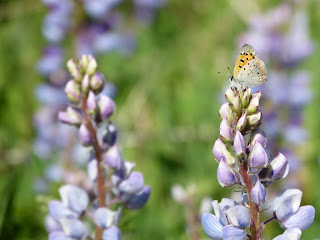My interest in dragonflies and damselflies (collectively referred to as odonates) has grown a lot over the past few years - in part due to the many great field guides that are now available. I think this is a growing trend among birdwatchers/naturalists. I'm going to photograph some of the species found in and around Norfolk County and put them on this blog. Perhaps this will encourage others to get interested in odonates as well! I'll be putting up photos of common species as well as any that are more hard to find.
The following 4 photos are all of immature females. I don't think too much should be read into this as I saw males, but just didn't get any good photos. It would make sense they aren't mature since it's early in the season.
Eastern Forktail - immature female. Probably our most common damselfly and highly variable in colour. Imm. female features: orange in colour, black shoulder stripe, dark abdomen that lacks any blue or orange on last segments. These were at a boggy area at Turkey Point, May 23/2012.
Fragile Forktail - immature females. Fairly common; look for the broken pale shoulder stripe.
Top one from Turkey Point, May 23/2012. Bottom one from Long Point Provincial Park
May 22/2012.
Skimming Bluet - male. Common bluet found in a variety of wetland habitats. This is a "black-type" bluet meaning that its abdomen is predominantly dark. Abdominal segments 8 and 9 are blue, and segment 2 has a unique, wavy blue marking. Turkey Point May 23/2012.
The following photos are all unidentified bluets belonging to the "mostly-blue" group of bluets. They are either Familiar Bluet, Hagen's Bluet, or Marsh Bluet. For identification, one needs to use a hand lens on males, or a microscope for the females. I did not go to those lengths this week. I suspect they are Marsh Bluets, but I can't be certain. All were photographed at L.P.P.P on May 22/2012.
Males above, females below.


























+St.+Williams+compressed.jpg)






















